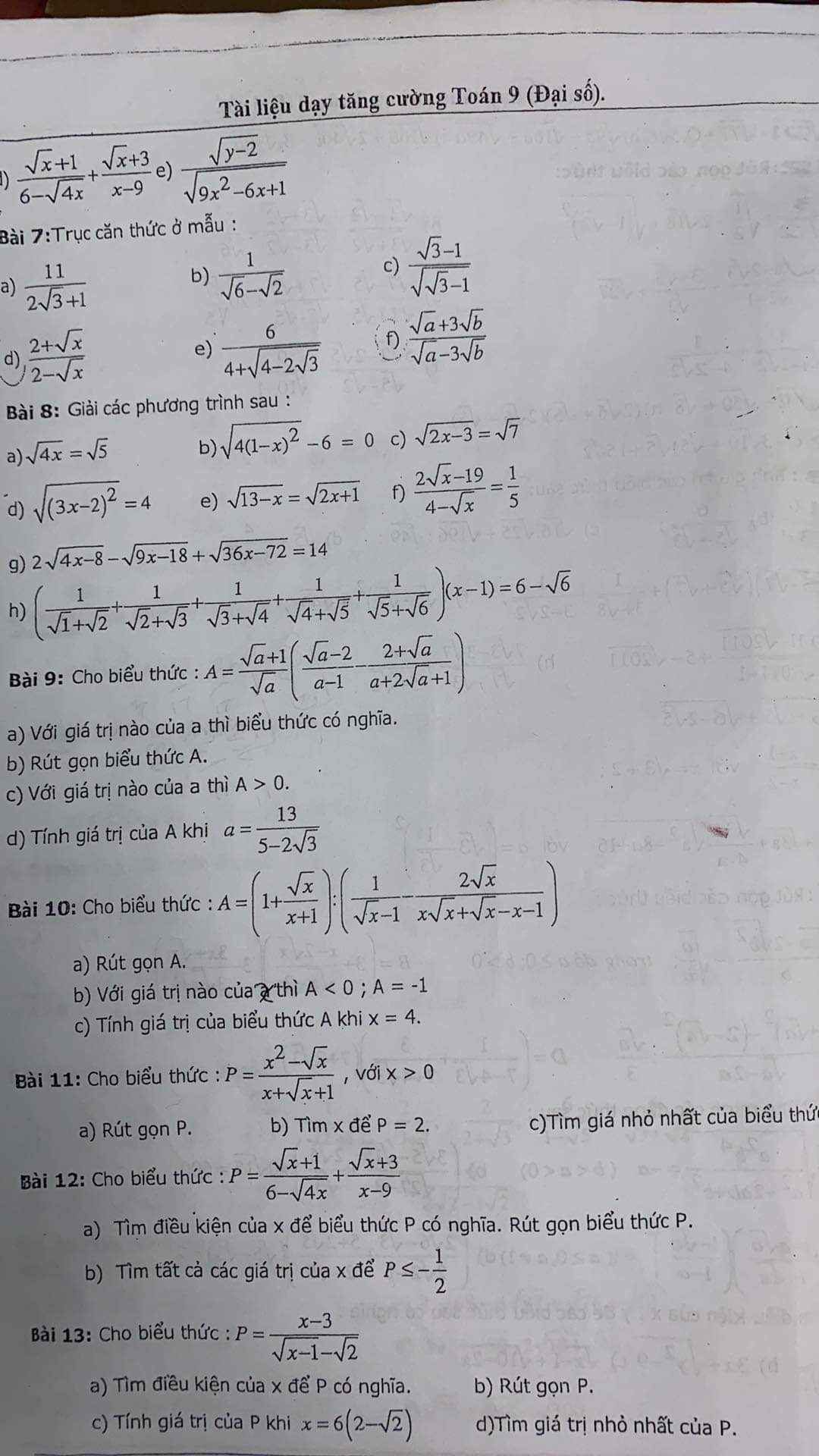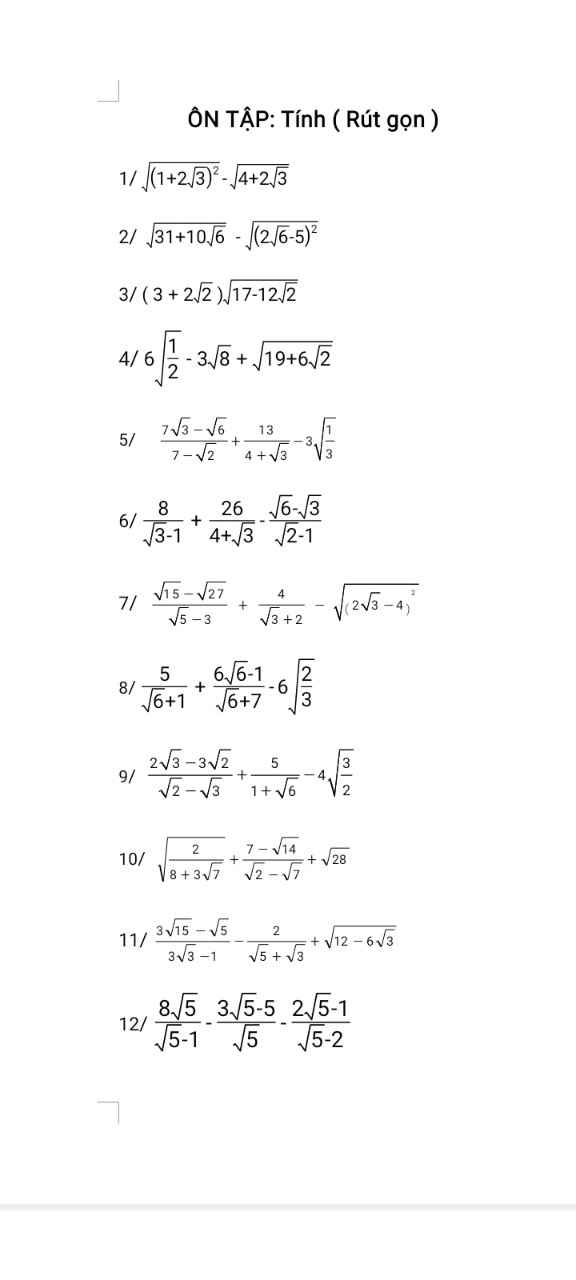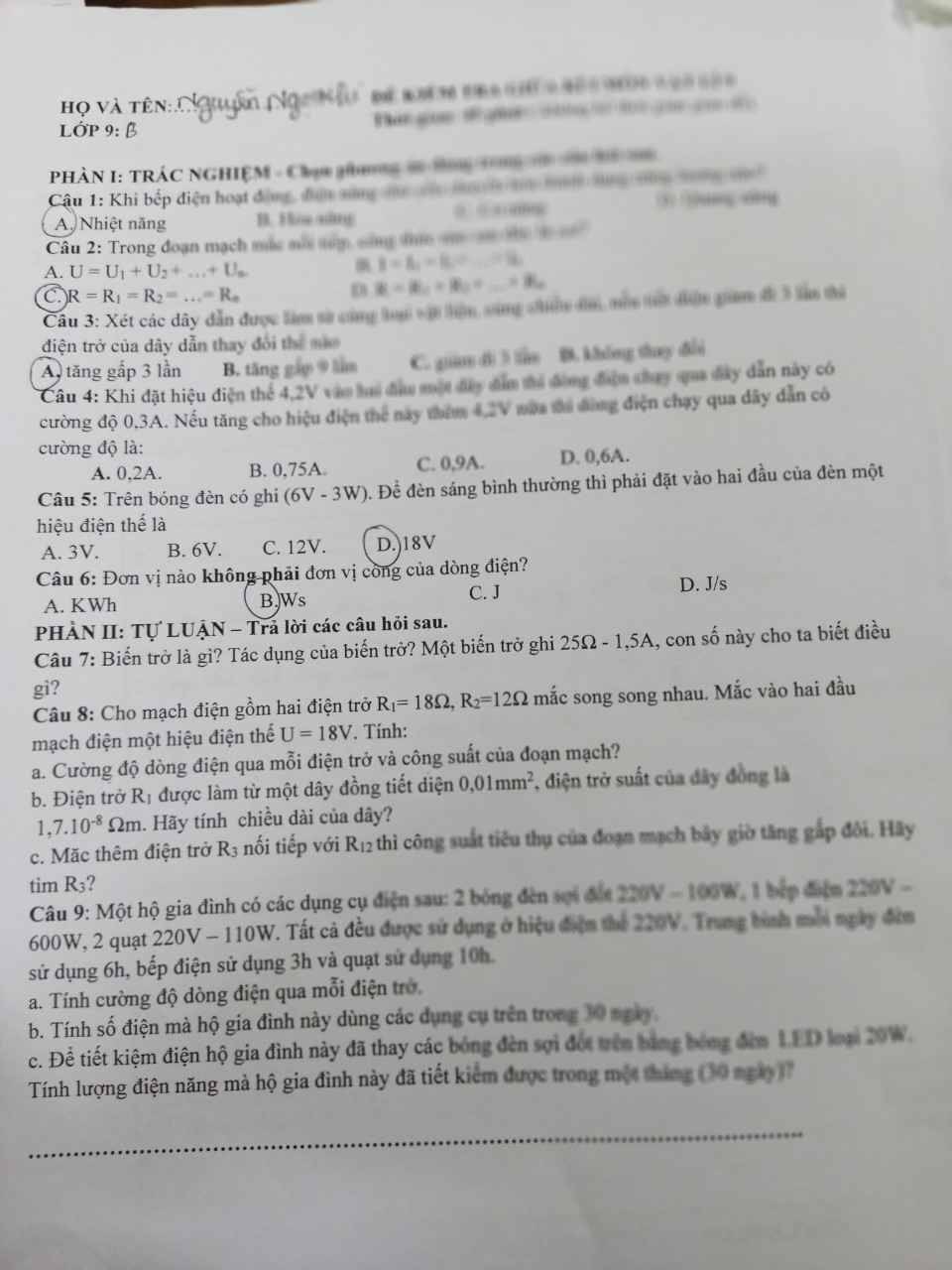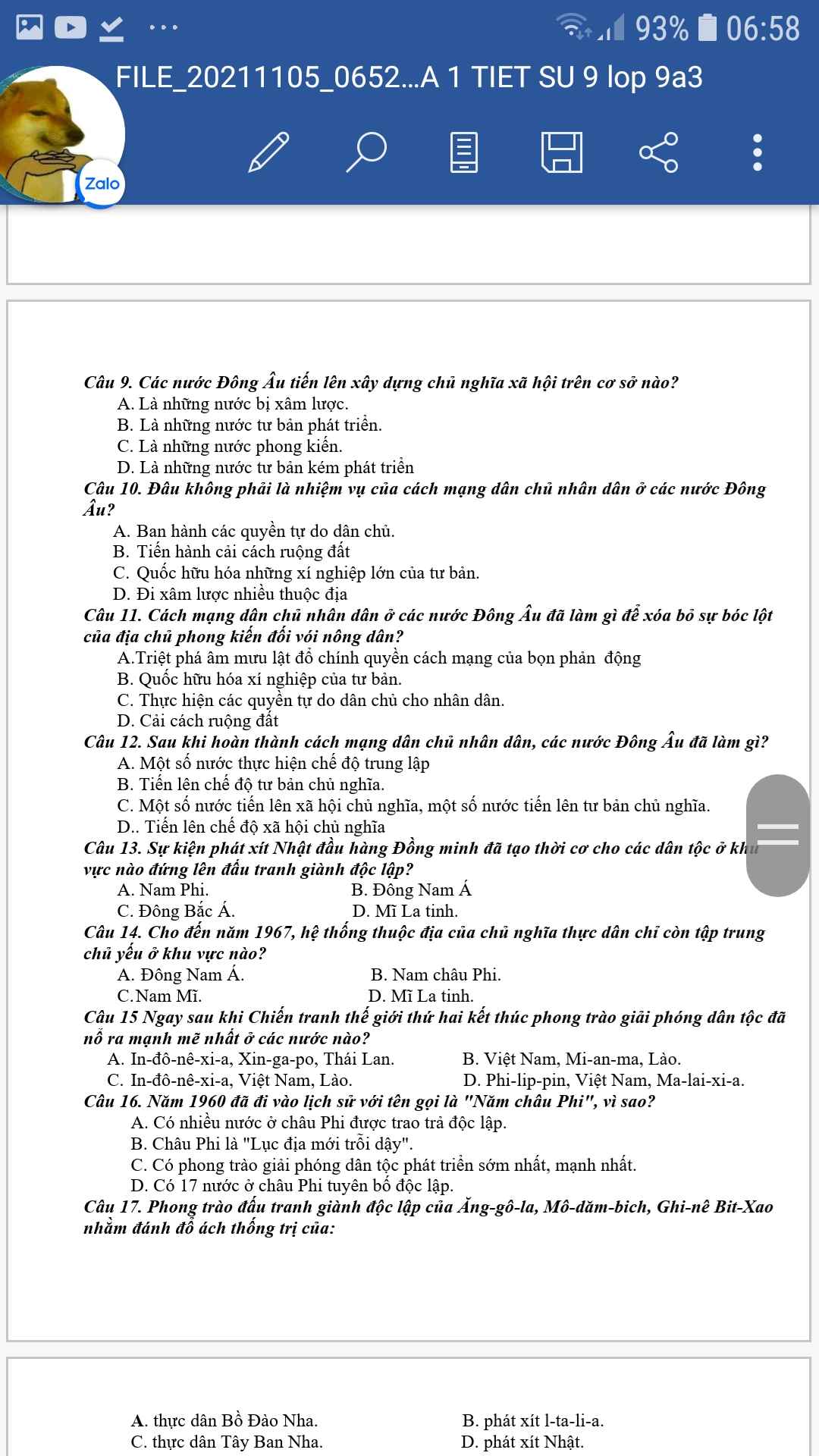làm câu 8 và câu 9 giúp mình với ạ
Hãy nhập câu hỏi của bạn vào đây, nếu là tài khoản VIP, bạn sẽ được ưu tiên trả lời.


8.
Gọi \(A\left(x_0;y_0\right)\) là điểm cố định mà đt luôn đi qua với mọi m
\(\Leftrightarrow mx_0+2y_0-3my_0+m-1=0\\ \Leftrightarrow m\left(x_0-3y_0+1\right)+\left(2y_0-1\right)=0\\ \Leftrightarrow\left\{{}\begin{matrix}x_0-3y_0+1=0\\2y_0-1=0\end{matrix}\right.\Leftrightarrow\left\{{}\begin{matrix}x_0=\dfrac{1}{2}\\y_0=\dfrac{1}{2}\end{matrix}\right.\Leftrightarrow A\left(\dfrac{1}{2};\dfrac{1}{2}\right)\)
Vậy đt luôn đi qua \(A\left(\dfrac{1}{2};\dfrac{1}{2}\right)\) với mọi m
9.
PT giao Ox là \(y=0\Leftrightarrow mx+m-1=0\Leftrightarrow x=\dfrac{1-m}{m}\Leftrightarrow A\left(\dfrac{1-m}{m};0\right)\Leftrightarrow OA=\left|\dfrac{1-m}{m}\right|\)
PT giao Oy là \(x=0\Leftrightarrow\left(2-3m\right)y+m-1=0\Leftrightarrow y=\dfrac{1-m}{2-3m}\Leftrightarrow B\left(0;\dfrac{1-m}{2-3m}\right)\Leftrightarrow OB=\left|\dfrac{1-m}{2-3m}\right|\)
Để \(\Delta OAB\) cân thì \(OA=OB\Leftrightarrow\left|\dfrac{1-m}{m}\right|=\left|\dfrac{1-m}{2-3m}\right|\)
\(\Leftrightarrow\left|m\right|=\left|2-3m\right|\Leftrightarrow\left[{}\begin{matrix}m=2-3m\\m=3m-2\end{matrix}\right.\Leftrightarrow\left[{}\begin{matrix}m=\dfrac{1}{2}\\m=1\end{matrix}\right.\)
Vậy \(\left[{}\begin{matrix}m=\dfrac{1}{2}\\m=1\end{matrix}\right.\) thỏa mãn đề


Bài 9:
b: Tọa độ giao điểm là:
\(\left\{{}\begin{matrix}2x-3=-3x+7\\y=2x-3\end{matrix}\right.\Leftrightarrow\left\{{}\begin{matrix}x=2\\y=1\end{matrix}\right.\)

8a.
\(\lim\limits_{x\rightarrow1^+}f\left(x\right)=\lim\limits_{x\rightarrow1^+}\left(3x^2-5x+1\right)=3-5+1=-1\)
\(\lim\limits_{x\rightarrow1^-}f\left(x\right)=\lim\limits_{x\rightarrow1^-}\left(-3x+2\right)=-3+2=-1\)
\(\Rightarrow\lim\limits_{x\rightarrow1^+}f\left(x\right)=\lim\limits_{x\rightarrow1^-}f\left(x\right)\Rightarrow\) hàm có giới hạn tại \(x=1\)
Đồng thời \(\lim\limits_{x\rightarrow1}f\left(x\right)=-1\)
b.
\(\lim\limits_{x\rightarrow2^+}f\left(x\right)=\lim\limits_{x\rightarrow2^+}\dfrac{x^3-8}{x-2}=\lim\limits_{x\rightarrow2^+}\dfrac{\left(x-2\right)\left(x^2+2x+4\right)}{x-2}\)
\(=\lim\limits_{x\rightarrow2^+}\left(x^2+2x+4\right)=12\)
\(\lim\limits_{x\rightarrow2^-}f\left(x\right)=\lim\limits_{x\rightarrow2^-}\left(2x+1\right)=5\)
\(\Rightarrow\lim\limits_{x\rightarrow2^+}f\left(x\right)\ne\lim\limits_{x\rightarrow2^-}f\left(x\right)\Rightarrow\) hàm ko có giới hạn tại x=2
9.
\(\lim\limits_{x\rightarrow0^+}f\left(x\right)=\lim\limits_{x\rightarrow0^+}\dfrac{x^2+mx+2m+1}{x+1}=\dfrac{0+0+2m+1}{0+1}=2m+1\)
\(\lim\limits_{x\rightarrow0^-}f\left(x\right)=\lim\limits_{x\rightarrow0^-}\dfrac{2x+3m-1}{\sqrt{1-x}+2}=\dfrac{0+3m-1}{1+2}=\dfrac{3m-1}{3}\)
Hàm có giới hạn khi \(x\rightarrow0\) khi:
\(\lim\limits_{x\rightarrow0^+}f\left(x\right)=\lim\limits_{x\rightarrow0^-}f\left(x\right)\Rightarrow2m+1=\dfrac{3m-1}{3}\)
\(\Rightarrow m=-\dfrac{4}{3}\)

\(9,=\dfrac{\sqrt{6}\left(\sqrt{2}-\sqrt{3}\right)}{\sqrt{2}-\sqrt{3}}+\dfrac{5\left(1-\sqrt{6}\right)}{-5}-2\sqrt{6}\\ =\sqrt{6}-1+\sqrt{6}-2\sqrt{6}=-1\)

Câu 8.
a)\(R_1//R_2\Rightarrow R_{12}=\dfrac{R_1\cdot R_2}{R_1+R_2}=\dfrac{18\cdot12}{18+12}=7,2\Omega\)
\(I=\dfrac{U}{R}=\dfrac{18}{7,2}=2,5A\)
\(U_1=U_2=U=18V\)
\(I_1=\dfrac{U_1}{R_1}=\dfrac{18}{18}=1A\)
\(I_2=I-I_1=2,5-1=1,5A\)
\(P_m=\dfrac{U_m^2}{R_{tđ}}=\dfrac{18^2}{7,2}=45W\)
b)Chiều dài dây \(l_1\) là: \(R_1=\rho\cdot\dfrac{l_1}{S_1}\)
\(\Rightarrow18=1,7\cdot10^{-8}\cdot\dfrac{l_1}{0,01\cdot10^{-8}}\Rightarrow l_1=\dfrac{9}{85}m\approx0,106m\)
c)Công suất tiêu thụ của đoạn mạch tăng gấp đôi: \(P_m=2\cdot45=90W\)
Điện trở tương đương: \(R_{tđ}=\dfrac{U^2}{P_m}=\dfrac{18^2}{90}=3,6\)
Thay đề bài thành
\(R_3//R_{12}\Rightarrow R_{tđ}=\dfrac{R_3\cdot R_{12}}{R_3+R_{12}}=\dfrac{R_3\cdot7,2}{R_3+7,2}=3,6\Rightarrow R_3=7,2\Omega\)
Câu 9.
\(R_đ=\dfrac{U_1^2}{P_1}=\dfrac{220^2}{100}=484\Omega;I_đ=\dfrac{P_1}{U_1}=\dfrac{100}{220}=\dfrac{5}{11}A\)
\(R_b=\dfrac{U_2^2}{P_2}=\dfrac{220^2}{600}=\dfrac{242}{3}\Omega;I_b=\dfrac{P_2}{U_2}=\dfrac{600}{220}=\dfrac{30}{11}A\)
\(R_q=\dfrac{U_3^2}{P_3}=\dfrac{220^2}{110}=440\Omega;I_q=\dfrac{P_3}{U_3}=\dfrac{110}{220}=0,5A\)
a)\(R_{tđ}=R_1+R_2+R_3=484+\dfrac{242}{3}+440=\dfrac{3014}{3}\Omega\)
\(I_1=I_2=I_3=I=\dfrac{U}{R_{tđ}}=\dfrac{220}{\dfrac{3014}{3}}=\dfrac{30}{137}A\approx0,22A\)
b)Điện năng mà các vật tiêu thụ trong 30 ngày là:
\(A_đ=\dfrac{U_đ^2}{R_đ}\cdot t=\dfrac{220^2}{484}\cdot6\cdot3600\cdot30=64800000J=18kWh\)
\(A_b=\dfrac{U_b^2}{R_b}\cdot t=\dfrac{220^2}{\dfrac{242}{3}}\cdot3\cdot3600\cdot30=194400000J=54kWh\)
\(A_q=\dfrac{U^2_q}{R_q}\cdot t=\dfrac{220^2}{440}\cdot10\cdot3600\cdot30=118800000J=33kWh\)
\(A=A_đ+A_b+A_q=18+54+33=105kWh\)
Câu 8. \(R_1\left|\right|R_2\)
(a) Cường độ dòng điện qua các điện trở:
\(\left\{{}\begin{matrix}I_1=\dfrac{U}{R_1}=\dfrac{18}{18}=1\left(A\right)\\I_2=\dfrac{U}{R_2}=\dfrac{18}{12}=1,5\left(A\right)\end{matrix}\right.\)
Công suất của mạch: \(P=\dfrac{U^2}{R}=\dfrac{U^2}{\dfrac{R_1R_2}{R_1+R_2}}=\dfrac{18^2}{\dfrac{18\cdot12}{18+12}}=45\left(W\right)\)
(b) \(S=0,01\left(mm^2\right)=10^{-8}\left(m^2\right)\)
Chiều dài dây: \(R_1=\rho\cdot\dfrac{l}{S}\Rightarrow l=\dfrac{R_1S}{\rho}=\dfrac{18\cdot10^{-8}}{1,7\cdot10^{-8}}\approx10,59\left(m\right)\)
(c) Đề sai.


9. NaHCO3 + HCl → NaCl + H2O + CO2
=> PT ion : \(HCO_3^-+H^+\rightarrow CO_2+H_2O\)
10. NaHCO3 + NaOH → Na2CO3 + H2O
=> PT ion : \(HCO_3^-+OH^-\rightarrow CO_3^{2-}+H_2O\)
11. NH4Cl + NaOH → NH3 + H2O + NaCl
=> PT ion :\(NH_4^++OH^-\rightarrow NH_3+H_2O\)
12. Na2SO4 + FeCl3 -----//---->

6. Egypt is believed to be the driest country in the world.
7. The Taj is said to have been built with blind people who couldn't see how beautiful it is.
8. He is alleged to have kicked a policeman.
9. The train was supposed to arrive at 11.30.
10. The two injured men are thought to have been repairing overhead cables.









Bài 8:
a: Ta có: \(\sqrt{4x}=\sqrt{5}\)
\(\Leftrightarrow4x=5\)
hay \(x=\dfrac{5}{4}\)
b: Ta có: \(\sqrt{4\cdot\left(1-x\right)^2}-6=0\)
\(\Leftrightarrow2\left|x-1\right|=6\)
\(\Leftrightarrow\left|x-1\right|=3\)
\(\Leftrightarrow\left[{}\begin{matrix}x-1=3\\x-1=-3\end{matrix}\right.\Leftrightarrow\left[{}\begin{matrix}x=4\\x=-2\end{matrix}\right.\)
c: Ta có: \(\sqrt{2x-3}=\sqrt{7}\)
\(\Leftrightarrow2x-3=7\)
hay x=5
d: Ta có: \(\sqrt{\left(3x-2\right)^2}=4\)
\(\Leftrightarrow\left|3x-2\right|=4\)
\(\Leftrightarrow\left[{}\begin{matrix}3x-2=4\\3x-2=-4\end{matrix}\right.\Leftrightarrow\left[{}\begin{matrix}3x=6\\3x=-2\end{matrix}\right.\Leftrightarrow\left[{}\begin{matrix}x=2\\x=-\dfrac{2}{3}\end{matrix}\right.\)